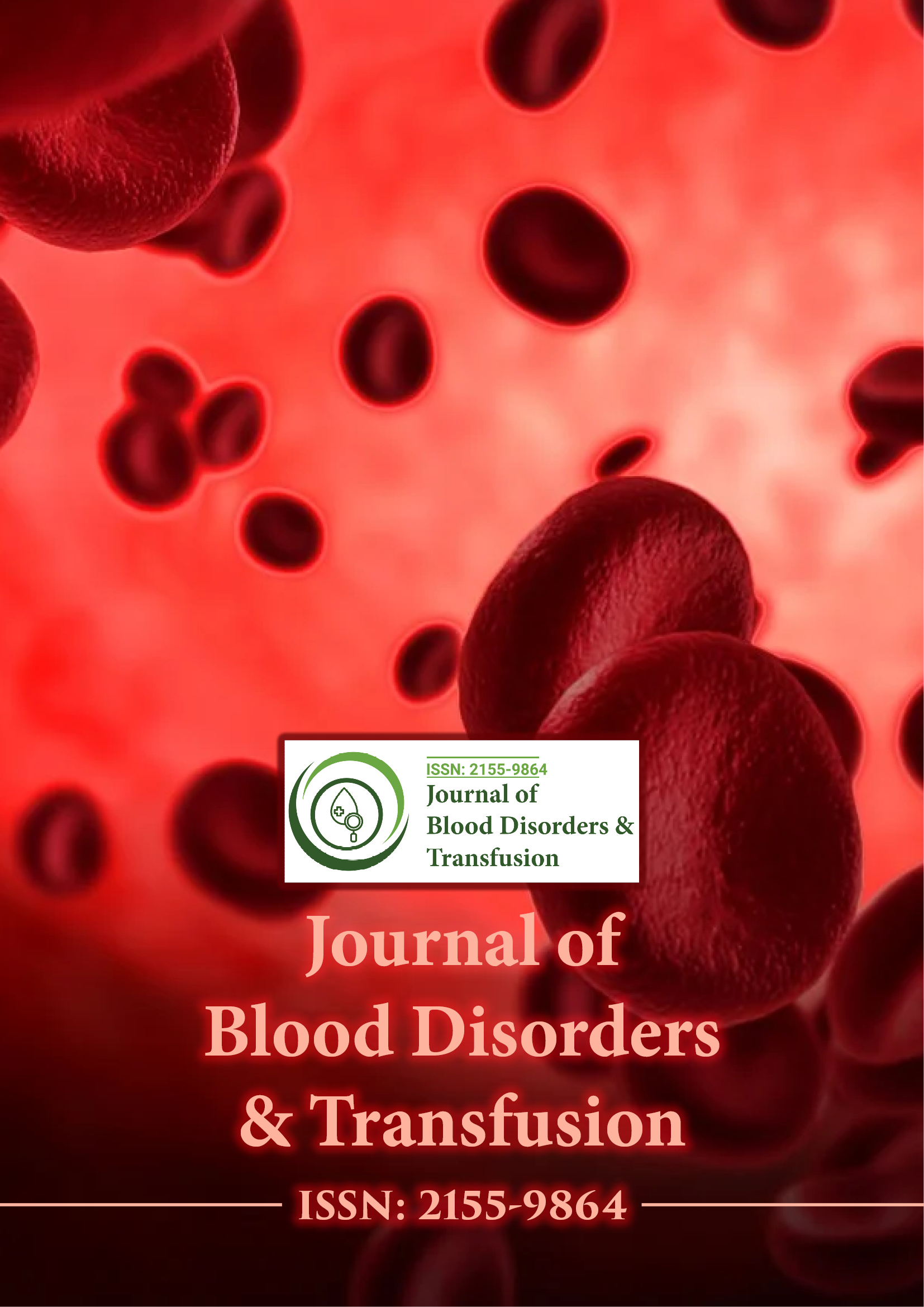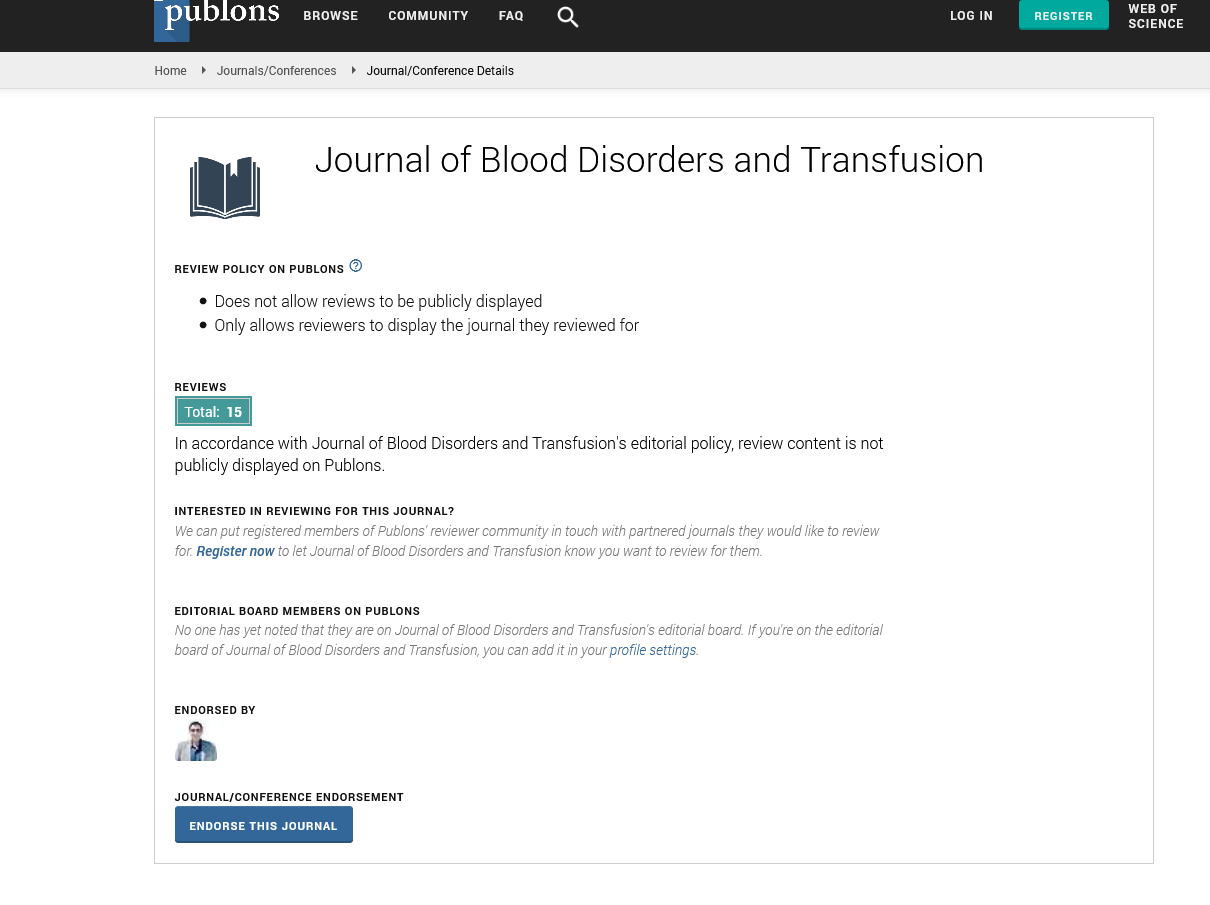Indexed In
- Open J Gate
- Genamics JournalSeek
- JournalTOCs
- Ulrich's Periodicals Directory
- RefSeek
- Hamdard University
- EBSCO A-Z
- OCLC- WorldCat
- Proquest Summons
- Publons
- Geneva Foundation for Medical Education and Research
- Euro Pub
- Google Scholar
Useful Links
Share This Page
Journal Flyer

Open Access Journals
- Agri and Aquaculture
- Biochemistry
- Bioinformatics & Systems Biology
- Business & Management
- Chemistry
- Clinical Sciences
- Engineering
- Food & Nutrition
- General Science
- Genetics & Molecular Biology
- Immunology & Microbiology
- Medical Sciences
- Neuroscience & Psychology
- Nursing & Health Care
- Pharmaceutical Sciences
Opinion Article - (2024) Volume 15, Issue 7
Advancements in Biomarker Discovery for the Detection and Diagnosis of Hematological Disorders
Emely Bidwan*Received: 20-Nov-2024, Manuscript No. JBDT-24-27678; Editor assigned: 22-Nov-2024, Pre QC No. JBDT-24-27678 (PQ); Reviewed: 10-Dec-2024, QC No. JBDT-24-27678; Revised: 17-Dec-2024, Manuscript No. JBDT-24-27678 (R); Published: 24-Dec-2024, DOI: 10.4172/2155-9864.24.15.608
Description
Blood disorders encompass a wide range of conditions, from anemias and clotting disorders to cancers such as leukemia and lymphoma. Early diagnosis is significant for effective treatment and improved patient outcomes. Biomarkers-biological molecules that indicate normal or pathological processes-are increasingly recognized as valuable tools for the early detection of blood disorders. This article explains the latest advancements in identifying and utilizing emerging biomarkers, highlighting their important to revolutionize diagnostics and patient care.
Importance of diagnosis
Detecting blood disorders at an early stage enables timely intervention, improving the prognosis and reducing the burden of disease. For instance:
• In anemias, early detection allows prompt treatment to prevent complications like organ damage.
• In malignancies like leukemia, early diagnosis is linked to higher survival rates due to more effective treatment options.
• In clotting disorders such as hemophilia or thrombophilia, early identification can prevent life-threatening events like severe bleeding or thrombosis.
The biomarkers are non-invasive, accurate and rapid means of diagnosing these conditions, overcoming limitations of traditional diagnostic methods.
Types of biomarkers in blood disorders
Advances in genomic technologies have identified mutations and gene expression patterns associated with specific blood disorders. For example, mutations in the JAK2 gene are indicative of myeloproliferative neoplasms.
• Next-Generation Sequencing (NGS) enables the identification of rare genetic variants linked to inherited anemias or coagulation disorders.
• Proteins such as ferritin and hepcidin are widely used to diagnose iron deficiency and regulate iron metabolism.
• Novel proteomic biomarkers have been linked to early inflammation in autoimmune hemolytic anemias.
• Alterations in Deoxyribo Nucleic Acid (DNA) methylation or histone modifications serve as indicators of certain blood cancers, such as Acute Myeloid Leukemia (AML).
• Hypermethylation of tumor suppressor genes is being investigated as a diagnostic tool for lymphomas.
• Metabolic profiles, including changes in metabolites like lactate or amino acids, are emerging as markers for diseases such as multiple myeloma or sickle cell anemia.
• Advanced mass spectrometry techniques aid in identifying disease-specific metabolic signatures.
• Circulating tumor DNA (ctDNA) and cell-free Ribo Nucleic Acid (RNA) are being explored for the early detection of hematologic malignancies.
These biomarkers provide insights into tumor burden and treatment response in real time.
Advances in biomarker discovery
• Technologies like NGS and proteomics platforms enable the rapid identification of novel biomarkers across diverse patient populations.
• AI-powered algorithms analyze complex datasets to uncover patterns and correlations, accelerating biomarker discovery and validation.
• Combining data from genomics, proteomics and metabolomics provides a holistic view of disease biology, enhancing diagnostic accuracy.
• Non-invasive liquid biopsies detect biomarkers in blood or plasma, offering a less intrusive alternative to traditional tissue biopsies.
Clinical applications of biomarkers
Biomarkers like BCR-ABL1 are critical for diagnosing Chronic Myeloid Leukemia (CML) and stratifying patients based on their risk of progression.
• Genetic testing for hemoglobinopathies, such as mutations in the HBB gene, aids in diagnosing sickle cell disease.
• Biomarkers like Beta-2 Microglobulin (B2M) are used to monitor disease progression in multiple myeloma.
• Quantifying ctDNA levels provides insights into relapse in hematologic cancers.
• Biomarker mutations help predict the efficacy of targeted therapies in AML.
• Monitoring levels of von Willebrand factor (vWF) informs treatment decisions in clotting disorders.
The biomarkers are transforming the early diagnosis of blood disorders, offering unprecedented accuracy and insights into disease mechanisms. As technologies evolve, these biomarkers contain the significant to revolutionize patient care, enabling earlier interventions and better outcomes. Overcoming challenges in validation, accessibility and ethical concerns will be significant for fully realizing their significances in clinical practice.
Citation: Bidwan E (2024). Advancements in Biomarker Discovery for the Detection and Diagnosis of Hematological Disorders. J Blood Disord Transfus. 15:608.
Copyright: © 2024 Bidwan E. This is an open-access article distributed under the terms of the Creative Commons Attribution License, which permits unrestricted use, distribution, and reproduction in any medium, provided the original author and source are credited.

